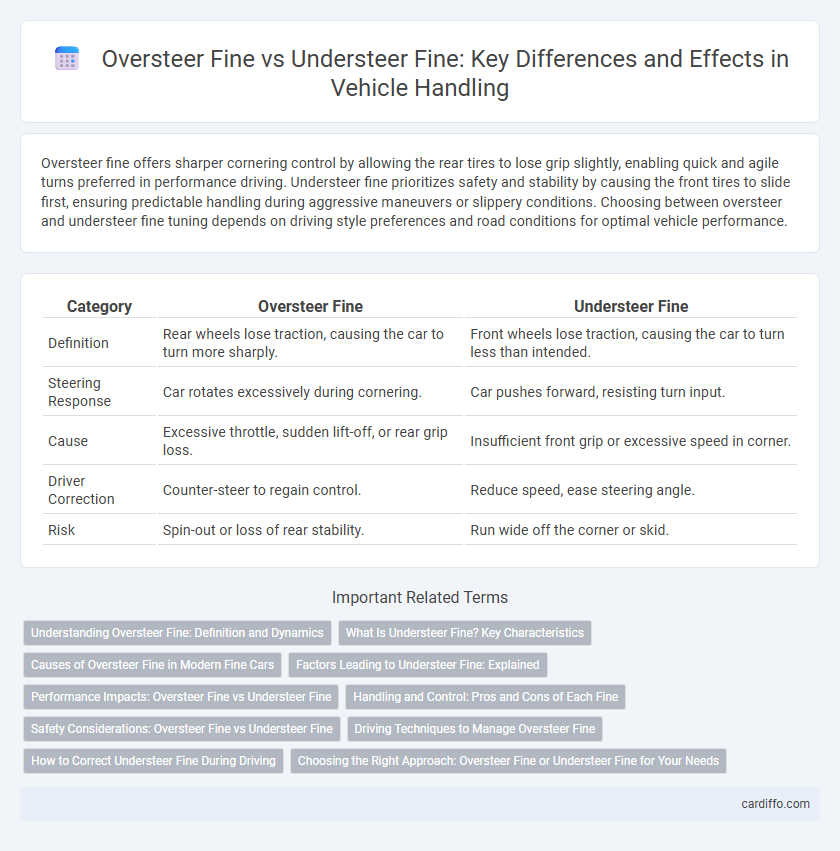Oversteer fine offers sharper cornering control by allowing the rear tires to lose grip slightly, enabling quick and agile turns preferred in performance driving. Understeer fine prioritizes safety and stability by causing the front tires to slide first, ensuring predictable handling during aggressive maneuvers or slippery conditions. Choosing between oversteer and understeer fine tuning depends on driving style preferences and road conditions for optimal vehicle performance.
Table of Comparison
| Category | Oversteer Fine | Understeer Fine |
|---|---|---|
| Definition | Rear wheels lose traction, causing the car to turn more sharply. | Front wheels lose traction, causing the car to turn less than intended. |
| Steering Response | Car rotates excessively during cornering. | Car pushes forward, resisting turn input. |
| Cause | Excessive throttle, sudden lift-off, or rear grip loss. | Insufficient front grip or excessive speed in corner. |
| Driver Correction | Counter-steer to regain control. | Reduce speed, ease steering angle. |
| Risk | Spin-out or loss of rear stability. | Run wide off the corner or skid. |
Understanding Oversteer Fine: Definition and Dynamics
Oversteer fine occurs when the rear wheels lose traction before the front wheels, causing the vehicle's rear to swing outward during a turn, demanding precise driver control to maintain stability. This condition typically arises from aggressive throttle input or sharp steering maneuvers, emphasizing the importance of weight transfer and tire grip in dynamic handling. Understanding oversteer fine helps drivers anticipate vehicle behavior, improving cornering performance and safety.
What Is Understeer Fine? Key Characteristics
Understeer fine occurs when a vehicle's front wheels lose grip during a turn, causing the car to steer less sharply than intended. Key characteristics include a reluctance to turn, a wide turning radius, and a sensation of the vehicle pushing forward rather than following the steering input. This condition is often caused by insufficient front tire traction or excessive speed entering a corner, and it is typically safer and easier to control than oversteer.
Causes of Oversteer Fine in Modern Fine Cars
Oversteer in modern fine cars is primarily caused by excessive rear-wheel traction loss due to sudden throttle changes or sharp steering inputs, often exacerbated by rear-wheel drive configurations. Advanced electronic stability control systems can modulate brake force and engine power to mitigate oversteer by restoring balanced traction. Additionally, factors such as suspension setup, tire grip, and weight distribution significantly influence the likelihood of oversteer during dynamic driving conditions.
Factors Leading to Understeer Fine: Explained
Understeer fine occurs when the front tires lose grip, causing the vehicle to continue straight despite steering input, often due to factors such as excessive speed in corners, worn front tires, or incorrect tire pressure. Vehicle weight distribution and suspension settings also contribute significantly, with front-heavy cars or improper suspension alignment increasing the likelihood of understeer. Understanding these elements helps drivers adjust driving techniques and vehicle setup to minimize understeer and improve overall handling performance.
Performance Impacts: Oversteer Fine vs Understeer Fine
Oversteer fine enhances cornering agility by allowing the rear wheels to slip slightly, improving maneuverability during high-speed turns but requiring precise driver control to avoid spinning out. Understeer fine causes the front wheels to lose grip, resulting in a wider turning radius and reduced responsiveness, which can compromise lap times and overall handling performance. Performance impacts show that oversteer fine suits aggressive driving styles seeking sharp cornering, while understeer fine provides stability but at the cost of slower corner exit speeds.
Handling and Control: Pros and Cons of Each Fine
Oversteer fine allows sharper cornering control and quicker vehicle response but demands higher skill to prevent loss of traction, increasing the risk of spinning out. Understeer fine provides more stable and predictable handling, making it safer for less experienced drivers, though it compromises agility and slows cornering speed. Drivers must balance these trade-offs: oversteer fine enhances maneuverability at the cost of control, while understeer fine favors stability over sharp handling.
Safety Considerations: Oversteer Fine vs Understeer Fine
Oversteer fine occurs when the rear wheels lose traction, causing the vehicle to turn more sharply than intended, which can lead to fishtailing and loss of control, especially on slippery surfaces. Understeer fine happens when the front wheels lose grip, causing the vehicle to continue straight despite steering input, increasing the risk of collisions with obstacles or off-road terrain. Safety considerations prioritize understanding these dynamics for effective counter-steering techniques and maintaining control during high-speed or emergency maneuvers to prevent accidents.
Driving Techniques to Manage Oversteer Fine
Managing oversteer effectively requires precise countersteering and smooth throttle control to maintain vehicle balance and avoid spinouts. Drivers must practice shifting their weight by gently easing off the accelerator while steering into the skid to regain traction without triggering understeer. Developing a keen understanding of weight transfer and tire grip dynamics is essential for advanced control during oversteer situations.
How to Correct Understeer Fine During Driving
To correct understeer during driving, gently reduce throttle input to regain front tire traction and steer smoothly toward the desired direction. Avoid sudden steering or braking actions to prevent further loss of grip. Adjusting speed before entering corners and maintaining steady tire pressure also helps minimize understeer occurrences.
Choosing the Right Approach: Oversteer Fine or Understeer Fine for Your Needs
Selecting the appropriate approach between oversteer fine and understeer fine hinges on your driving style and vehicle dynamics preferences. Oversteer fine enhances rear-wheel grip, promoting sharper cornering and agile handling, ideal for experienced drivers seeking precision control. Understeer fine prioritizes front-wheel stability and predictable steering response, offering safer, more forgiving handling suited for everyday driving and less aggressive maneuvers.
Oversteer fine vs Understeer fine Infographic

 cardiffo.com
cardiffo.com